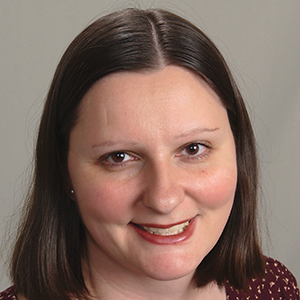
Stoddard changes mentoring practices in academia
Shana Stoddard says her goals are to “train people to be mentors,” to change the way people in academia think about mentoring, to connect students with role models and to help all students feel like they belong.
To achieve these goals, she has developed toolkits — frameworks and strategies, essentially — to help academics become engaging mentors.

For this work, Stoddard will receive the American Society for Biochemistry and Molecular Biology’s 2024 Ruth Kirschstein Diversity in Science Award, which honors “an outstanding scientist who has shown a sustained commitment to breaking down local and/or systemic barriers against scientists and students from historically marginalized or excluded groups.”
Loretta Jackson–Hayes, former chair and professor of chemistry at Rhodes College, nominated Stoddard for the award, noting the impact of mentoring practices that support students from underrepresented backgrounds. “Dr. Stoddard is a difference maker regarding increasing participation of students from underrepresented groups in biomedical careers,” Jackson–Hayes wrote.
Improved mentoring to build a strong pipeline in academia requires a mindset change, Stoddard said.
“People want change but are not ready to act,” she said, stressing that universities need to “create a new space where everyone can have a pathway forward.”
There are ways to make change without taking opportunity away from others, she added. “Creating change should not be perceived as a threat.”
Stoddard, an associate professor of chemistry, founded and leads the STEM Cohort Mentoring Program at Rhodes College, which centers Black and African American culture to meet the needs of students from historically underrepresented groups, helping them to complete science, technology, engineering and mathematics majors and go on to successful careers.
Stoddard completed undergraduate studies in chemistry at Prairie View A&M University and her Ph.D. in chemistry and biochemistry at the University of Mississippi. She holds a master’s degree from Freed–Hardeman University in curriculum and instruction with an emphasis on special education. She was a postdoc in radiological sciences/diagnostic imaging at St. Jude Children’s Research Hospital and a Hearst Postdoctoral Teaching Fellow at Rhodes, threading her interests in science and teaching throughout her career.
Stoddard said the ASBMB award represents “great affirmation that this work matters and is valued, and it shows that we need to keep doing it and that it’s making an impact.”
Threading two passions: Chemistry and teaching
Shana Stoddard’s lab works to develop peptide-based treatments for autoimmune disorders, including multiple sclerosis, lupus and primary membranous nephropathy. Her innovative research agenda attracts a wide range of underrepresented students to her lab.
Stoddard pursues her scientific and educational interests through her “Chemtutorials” project, which lets students learn about women and minorities in STEM, create practice problems and build mentoring relationships with professionals. “Role models are important,” she said, “and we want students to see what they could become.”
Her vision of creating role models and mentors for underrepresented students is key to Stoddard’s work at Rhodes College, and she plans to integrate her two passions in her award lecture at Discover BMB 2024 in San Antonio in March. Her talk is titled “Believe without boundaries” — reflecting her conviction that STEM can change and that everyone belongs.
2024 ASBMB award winners
Phillips turns parasite’s metabolic weakness into hope for human health
Herbert Tabor Research Award: Margaret Phillips
Ando's pioneering journey: From physics to structural enzymology
Mildred Cohn Young Investigator Award: Nozomi Ando
For Wolfson, every classroom is a laboratory
ASBMB Sustained Leadership Award: Adele Wolfson
Kennelly considers his fortune of three careers
William C. Rose Award for Exemplary Contributions to Education: Peter Kennelly
Balla leaves no phosphoinositide unturned
Avanti Award in Lipids: Tamas Balla
From virology to immunology, Wu focuses on structure
Bert & Natalie Vallee Award in Biomedical Science: Hao Wu
Stillman charts the path of genome replication
Earl And Thressa Stadtman Distinguished Scientist Award: Bruce Stillman
In failure, Simcox finds a way to learn
Walter A. Shaw Young Investigator in Lipid Research Award: Judith Simcox
Roos’ career pivot to maximize impact
Alice and C.C. Wang Award in Molecular Parasitology: David S. Roos
Enjoy reading ASBMB Today?
Become a member to receive the print edition four times a year and the digital edition monthly.
Learn moreGet the latest from ASBMB Today
Enter your email address, and we’ll send you a weekly email with recent articles, interviews and more.
Latest in People
People highlights or most popular articles

Building the blueprint to block HIV
Wesley Sundquist will present his work on the HIV capsid and revolutionary drug, Lenacapavir, at the ASBMB Annual Meeting, March 7–10, in Maryland.

In memoriam: Alan G. Goodridge
He made pioneering discoveries on lipid metabolism and was an ASBMB member since 1971.

Alrubaye wins research and teaching awards
He was honored at the NACTA 2025 conference for the Educator Award and at the U of A State and National Awards reception for the Faculty Gold Medal.

Designing life’s building blocks with AI
Tanja Kortemme, a professor at the University of California, San Francisco, will discuss her research using computational biology to engineer proteins at the 2026 ASBMB Annual Meeting.

Jordahl named Gilliam Fellow
He will receive three years of funding to support his thesis research.

Bibel named assistant professor
She began her position at Loyola Marymount University in August 2025.

